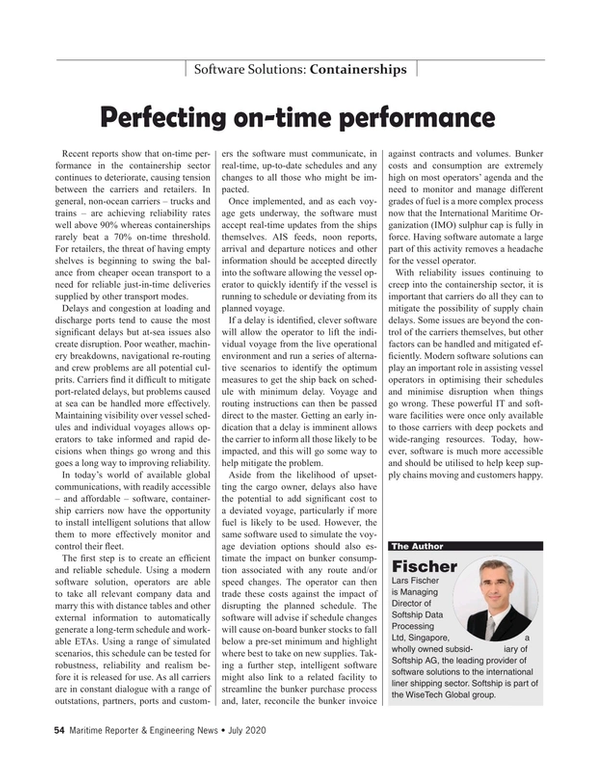
Container Shipping & Perfecting on-time Performance
Recent reports show that on-time performance in the containership sector continues to deteriorate, causing tension between the carriers and retailers. In general, non-ocean carriers – trucks and trains – are achieving reliability rates well above 90% whereas containerships rarely beat a 70% on-time threshold. For retailers, the threat of having empty shelves is beginning to swing the balance from cheaper ocean transport to a need for reliable just-in-time deliveries supplied by other transport modes.
Delays and congestion at loading and discharge ports tend to cause the most significant delays but at-sea issues also create disruption. Poor weather, machinery breakdowns, navigational re-routing and crew problems are all potential culprits. Carriers find it difficult to mitigate port-related delays, but problems caused at sea can be handled more effectively. Maintaining visibility over vessel schedules and individual voyages allows operators to take informed and rapid decisions when things go wrong and this goes a long way to improving reliability.
In today’s world of available global communications, with readily accessible – and affordable – software, containership carriers now have the opportunity to install intelligent solutions that allow them to more effectively monitor and control their fleet.
The first step is to create an efficient and reliable schedule. Using a modern software solution, operators are able to take all relevant company data and marry this with distance tables and other external information to automatically generate a long-term schedule and workable ETAs. Using a range of simulated scenarios, this schedule can be tested for robustness, reliability and realism before it is released for use. As all carriers are in constant dialogue with a range of outstations, partners, ports and customers the software must communicate, in real-time, up-to-date schedules and any changes to all those who might be impacted.
Once implemented, and as each voyage gets underway, the software must accept real-time updates from the ships themselves. AIS feeds, noon reports, arrival and departure notices and other information should be accepted directly into the software allowing the vessel operator to quickly identify if the vessel is running to schedule or deviating from its planned voyage.
If a delay is identified, clever software will allow the operator to lift the individual voyage from the live operational environment and run a series of alternative scenarios to identify the optimum measures to get the ship back on schedule with minimum delay. Voyage and routing instructions can then be passed direct to the master. Getting an early indication that a delay is imminent allows the carrier to inform all those likely to be impacted, and this will go some way to help mitigate the problem.
Aside from the likelihood of upsetting the cargo owner, delays also have the potential to add significant cost to a deviated voyage, particularly if more fuel is likely to be used. However, the same software used to simulate the voyage deviation options should also estimate the impact on bunker consumption associated with any route and/or speed changes. The operator can then trade these costs against the impact of disrupting the planned schedule. The software will advise if schedule changes will cause on-board bunker stocks to fall below a pre-set minimum and highlight where best to take on new supplies. Taking a further step, intelligent software might also link to a related facility to streamline the bunker purchase process and, later, reconcile the bunker invoice against contracts and volumes. Bunker costs and consumption are extremely high on most operators’ agenda and the need to monitor and manage different grades of fuel is a more complex process now that the International Maritime Organization (IMO) sulphur cap is fully in force. Having software automate a large part of this activity removes a headache for the vessel operator.
With reliability issues continuing to creep into the containership sector, it is important that carriers do all they can to mitigate the possibility of supply chain delays. Some issues are beyond the control of the carriers themselves, but other factors can be handled and mitigated efficiently. Modern software solutions can play an important role in assisting vessel operators in optimising their schedules and minimise disruption when things go wrong. These powerful IT and software facilities were once only available to those carriers with deep pockets and wide-ranging resources. Today, however, software is much more accessible and should be utilised to help keep supply chains moving and customers happy.

The Author: Lars Fischer is Managing Director of Softship Data Processing Ltd, Singapore, a wholly owned subsidiary of Softship AG, the leading provider of software solutions to the international liner shipping sector. Softship is part of the WiseTech Global group.
Read Container Shipping & Perfecting on-time Performance in Pdf, Flash or Html5 edition of July 2020 Maritime Reporter
Other stories from July 2020 issue
Content
- Opinion: Shame on Port States for the Treatment of Seafarers page: 12
- Training Tips for Ships #14: Collect, Analyze Data to Improve Training page: 14
- Profiles in Training: Marcus Cheesman, Founder, Seven Seas Preparatory Academy page: 16
- Leadership Development in the Merchant Marine: The Growing Significance for the Future page: 20
- Smart Management is Needed as Wave of Digitalization Transforms Maritime page: 22
- Ship Emissions: ABS Spearheads the Future of EEDI for Ships page: 24
- Interview: Captain Havard Ramsoy, Genting Cruise Lines, Plotting the Return Course for Cruising page: 28
- Five Minutes with George Whittier, CEO, Fairbanks Morse page: 30
- Ship Power: Inside WinGD's X-DF2.0 Technology page: 32
- Understanding Marine Autonomy: Today’s Market and Future Concerns page: 36
- Container Shipping & Perfecting on-time Performance page: 54
- Lithium Ion Battery Fires: A Threat to Container Shipping page: 56


